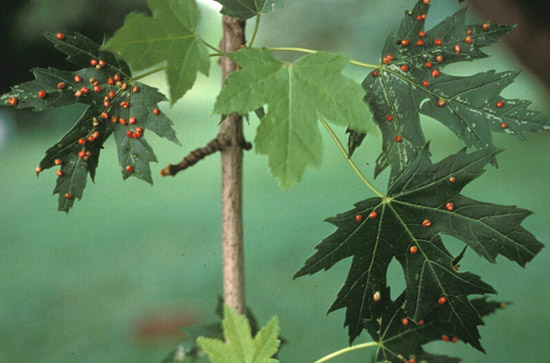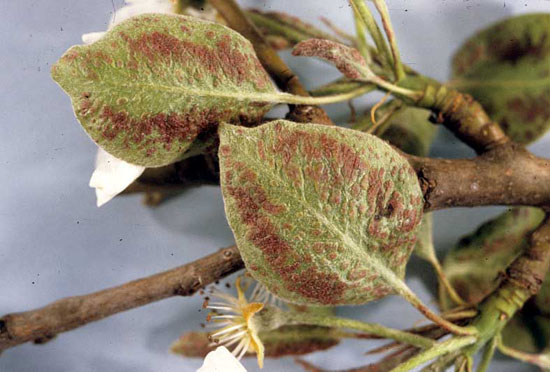Issue 3, May 7, 2010
Mite Leaf Galls
There are a number of eriophyid mite species that cause galls on trees at this time of year. Generally, these mites spend the winter under bud scales, then leaving the buds to attack expanding leaves. They typically feed on the leaf underside, eventually being enclosed inside the growing leaf tissue. Galls that are produced as a result of this feeding generally form on the leaf upperside even though the attack was on the underside.
Inspecting the younger galls will commonly reveal numerous mites. Eriophyid mites are different in appearance from spidermites, being very tiny, whitish, cigar-shaped, and with only four legs at one end. You will need a fairly strong hand lens to see them.
These galls can be prevented with miticides applied at leaf expansion. The mites that cause maple bladder gall and maple erineum galls have several generations per year, allowing the control of additional gall formation through the season with miticide applications after the galls first appear. However, all of these galls cause little damage to the trees. Considering the cost of control makes treatment generally unnecessary.
Maple bladder gall is obvious on silver maple leaves as bright red pinhead-sized nodules on the leaf upperside. The mite-caused galls are initially green before turning red. Later in the season, these galls will turn dark red and then black. There are several generations per year, so it is common in the summer to find green, red, and black galls all on the same leaf.

Maple Bladder Gall
Maple erineum is another mite gall that causes velvety patches typically one-quarter to one-half inch across on the underside of silver maple leaves. Like maple bladder gall, a close relative, the patches are initially green, turn red, and then darken to blackish.
Maple spindle gall is found on sugar maple leaves, more commonly in forest situations. Galls are upright and slender galls, about one-eighth inch long on the leaf upperside. Like the other maple galls, they turn from green to red.
Wild cherry pouch gall occurs primarily on wild black cherry, so is primarily noticed on trees at the edge of forests. The galls turn from green to red and appear as slender pouches up to one-eighth inch long on the leaf upperside.
Pearleaf blister mite is common on ornamental pears as well as fruit-bearing pears. The leaves have tiny blisters that are about one-sixteenth of an inch across and whitish, giving the appearance of whitish freckles on the leaf uppersides. On ornamentals pears, the leaf underside commonly has reddish streaks that turn blackish later in the season.

Pearleaf blister mite damage
--Phil Nixon
Author:
Phil Nixon